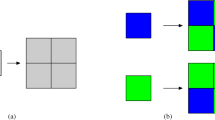Abstract
We demonstrate the potential of Kurt Bruckner’s ‘addition algorithm’, which is based on the substitution rule for the generation of the Robinson triangle tiling, a variant of the Penrose tiling. The artist Kurt Bruckner developed his straightforward approach intuitively for the creation of quasiperiodic ornaments. This versatile method can be used for the construction of achiral, homochiral and racemic quasiperiodic ornaments, as well as for the generation of decorated two-level (two-color) Penrose tilings. Therefore, the underlying tiling is always the same kind of Penrose tiling, which is invariant under the action of specific mirror and black/white mirror operations in contrast to unit tiles that are decorated in specific ways. Compared to the underlying classical substitution method the advantage of Kurt Bruckner’s approach is its simplicity and versatility for the creation of decorated tilings. Using a vector graphics editor, large and arbitrarily complex quasiperiodic ornaments can be easily generated manually.





Similar content being viewed by others
References
Mackay AL (1962) A dense non-crystallographic packing of equal spheres. Acta Crystallogr 15:916–918
Penrose R (1974) The role of aesthetics in pure and applied mathematical research. Bull Inst Math Appl 10:266–271
Mackay AL (1975) Generalised crystallography. Izvj Jugosl Centr Krist (Zagreb) 10:15–36
Gardner M (1977) Extraordinary nonperiodic tiling that enriches the theory of tiles. Sci Am 236(1):110–121
Mackay AL (1982) Crystallography and the Penrose pattern. Phys A 114:609–613
Shechtman D, Blech I, Gratias D, Cahn JW (1984) Metallic phase with long-range orientational order and no translational symmetry. Phys Rev Lett 53:1951–1953
Steurer W, Deloudi S (2009) Crystallography of quasicrystals. Concepts, methods and structures, vol 126., Springer series in materials science. Springer, Heidelberg
Grünbaum B, Shepard GC (1987) Tilings and patterns. Freeman, New York
Li XZ, Dubois JM, Kuo KH (1994) Two-colour Penrose tiling. Philos Mag Lett 69:93–98
Jaríc M (1986) Diffraction from quasicrystals: geometric structure factor. Phys Rev B 34:4685–4698
Lifshitz R (1997) Theory of color symmetry for periodic and quasiperiodic crystals. Rev Mod Phys 69:1181–1218
Steurer W, Haibach T (2001) Reciprocal-space images of aperiodic crystals. In: Shmueli U (ed) International tables for crystallography, vol B, chapter 4.6. Kluwer Academic Publishers, Dordrecht, pp 486–532
Author information
Authors and Affiliations
Corresponding author
Rights and permissions
About this article
Cite this article
Steurer, W., Arlitt, S. Kurt Bruckner’s view on the Penrose tiling. Struct Chem 28, 51–56 (2017). https://doi.org/10.1007/s11224-016-0790-1
Received:
Accepted:
Published:
Issue Date:
DOI: https://doi.org/10.1007/s11224-016-0790-1



